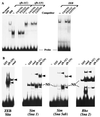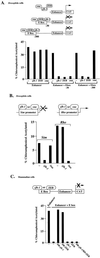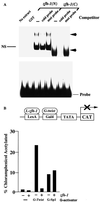zfh-1, the Drosophila homologue of ZEB, is a transcriptional repressor that regulates somatic myogenesis
- PMID: 10490660
- PMCID: PMC84718
- DOI: 10.1128/MCB.19.10.7255
zfh-1, the Drosophila homologue of ZEB, is a transcriptional repressor that regulates somatic myogenesis
Abstract
zfh-1 is a member of the zfh family of proteins, which all contain zinc finger and homeodomains. The roles and mechanisms of action of most family members are still unclear. However, we have shown previously that another member of the family, the vertebrate ZEB protein, is a transcriptional repressor that binds E box sequences and inhibits myotube formation in cell culture assays. zfh-1 is downregulated in Drosophila embryos prior to myogenesis. Embryos with zfh-1 loss-of-function mutation show alterations in the number and position of embryonic somatic muscles, suggesting that zfh-1 could have a regulatory role in myogenesis. However, nothing is known about the nature or mechanism of action of zfh-1. Here, we demonstrate that zfh-1 is a transcription factor that binds E box sequences and acts as an active transcriptional repressor. When zfh-1 expression was maintained in the embryo beyond its normal temporal pattern of downregulation, the differentiation of somatic but not visceral muscle was blocked. One potential target of zfh-1 in somatic myogenesis could be the myogenic factor mef2. mef2 is known to be regulated by the transcription factor twist, and we show here that zfh-1 binds to sites in the mef2 upstream regulatory region and inhibits twist transcriptional activation. Even though there is little sequence similarity in the repressor domains of ZEB and zfh-1, we present evidence that zfh-1 is the functional homologue of ZEB and that the role of these proteins in myogenesis is conserved from Drosophila to mammals.
Figures






Similar articles
-
ZEB, a vertebrate homolog of Drosophila Zfh-1, is a negative regulator of muscle differentiation.EMBO J. 1997 Jul 1;16(13):3935-43. doi: 10.1093/emboj/16.13.3935. EMBO J. 1997. PMID: 9233803 Free PMC article.
-
Independent repressor domains in ZEB regulate muscle and T-cell differentiation.Mol Cell Biol. 1999 Dec;19(12):7961-71. doi: 10.1128/MCB.19.12.7961. Mol Cell Biol. 1999. PMID: 10567522 Free PMC article.
-
ZEB represses transcription through interaction with the corepressor CtBP.Proc Natl Acad Sci U S A. 1999 Jun 8;96(12):6683-8. doi: 10.1073/pnas.96.12.6683. Proc Natl Acad Sci U S A. 1999. PMID: 10359772 Free PMC article.
-
Zinc finger proteins: watchdogs in muscle development.Mol Gen Genet. 1999 Mar;261(2):209-15. doi: 10.1007/s004380050959. Mol Gen Genet. 1999. PMID: 10102354 Review.
-
Regulation of muscle differentiation by the MEF2 family of MADS box transcription factors.Dev Biol. 1995 Nov;172(1):2-14. doi: 10.1006/dbio.1995.0002. Dev Biol. 1995. PMID: 7589800 Review. No abstract available.
Cited by
-
Opposing functions of ZEB proteins in the regulation of the TGFbeta/BMP signaling pathway.EMBO J. 2003 May 15;22(10):2443-52. doi: 10.1093/emboj/cdg225. EMBO J. 2003. PMID: 12743038 Free PMC article.
-
Drosophila, an Integrative Model to Study the Features of Muscle Stem Cells in Development and Regeneration.Cells. 2021 Aug 17;10(8):2112. doi: 10.3390/cells10082112. Cells. 2021. PMID: 34440881 Free PMC article. Review.
-
Zinc finger homeobox is required for the differentiation of serotonergic neurons in the sea urchin embryo.Dev Biol. 2012 Mar 1;363(1):74-83. doi: 10.1016/j.ydbio.2011.12.024. Epub 2011 Dec 22. Dev Biol. 2012. PMID: 22210002 Free PMC article.
-
Characterization of Drosophila Muscle Stem Cell-Like Adult Muscle Precursors.Methods Mol Biol. 2017;1556:103-116. doi: 10.1007/978-1-4939-6771-1_5. Methods Mol Biol. 2017. PMID: 28247346
-
A population of adult satellite-like cells in Drosophila is maintained through a switch in RNA-isoforms.Elife. 2018 Apr 9;7:e35954. doi: 10.7554/eLife.35954. Elife. 2018. PMID: 29629869 Free PMC article.
References
-
- Bate M. The mesoderm and its derivatives. In: Bate M, Martinez-Arias A, editors. The development of Drosophila melanoganster. Cold Spring Harbor, N.Y: Cold Spring Harbor Laboratory Press; 1993. pp. 1013–1090.
-
- Baylies M K, Bate M. Twist: a myogenic switch in Drosophila. Science. 1996;272:1481–1484. - PubMed
-
- Baylies M K, Bate M, Gomez M R. Myogenesis: a view from Drosophila. Cell. 1998;93:921–927. - PubMed
-
- Benezra R, Davis R L, Lockshon D, Turner D L, Weintraub H. The protein Id: a negative regulator of helix-loop-helix DNA binding proteins. Cell. 1990;61:49–59. - PubMed
-
- Bour B A, O’Brien M A, Lockwood W L, Goldstein E S, Bodmer R, Taghert P H, Abmayr S M, Nguyen H T. Drosophila Mef2, a transcription factor that is essential for myogenesis. Genes Dev. 1995;15:730–741. - PubMed
Publication types
MeSH terms
Substances
LinkOut - more resources
Full Text Sources
Other Literature Sources
Molecular Biology Databases
